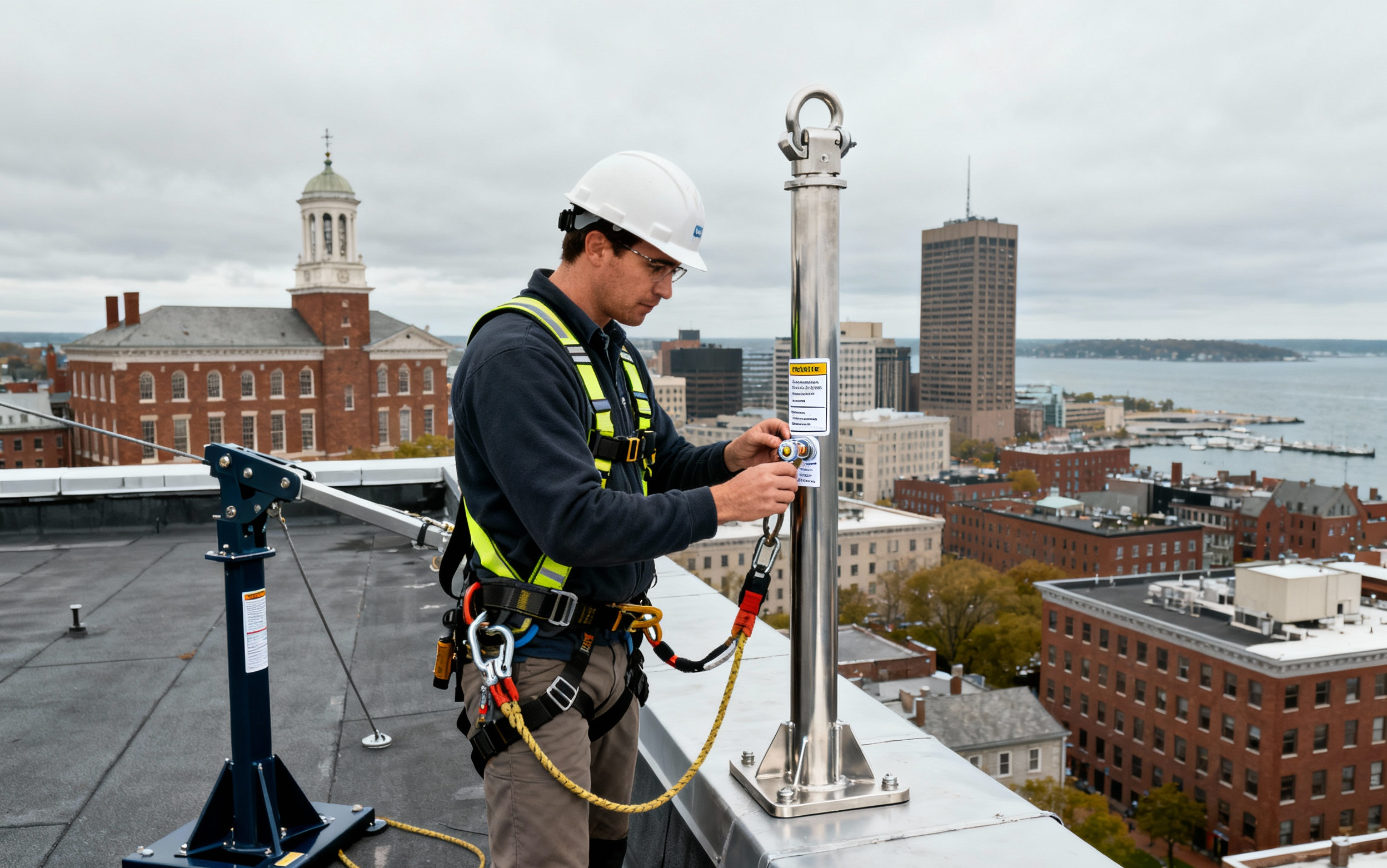
Picking a roof anchor isn’t just a line on a spec sheet—it’s a life-safety decision that has to work for your building, your tasks, and your climate. In Boston, MA, property managers balance historic construction, coastal weather, and year-round maintenance needs. This guide explains anchor types, what they’re rated to do, and how to match them to your facade work so crews are protected and projects move smoothly.
Start with your building and your work
Before you pick hardware, map the real jobs happening on your roof: window cleaning, facade inspections, sign work, HVAC service, or long-duration restoration. On many Boston, MA properties, teams switch between rope descent for quick tasks and suspended platforms for heavier work. Your anchor plan should support the highest-risk activity you authorize, not just the most common one.
Quick questions to answer:
- What tasks occur at height, and how often?
- How close are workable parapets and edges?
- What structural elements exist: concrete, steel, or wood framing?
- Who will own inspections and annual recertification?
Documenting this context helps your engineer select anchors that fit both the building and the day-to-day workflow in Boston, MA.
Know the anchor families
Not all anchors do the same job. Common categories include:
- Permanent single-point anchors: Fixed posts or flush plates for personal fall arrest or restraint. Ideal for routine tasks across many rooftops in Boston, MA.
- Davit bases and posts: For suspended access, bases remain on the roof, davit arms deploy as needed. Great where streets are narrow, which is common in parts of Boston, MA.
- Horizontal lifeline end anchors: Engineered terminations for cable systems that allow continuous tie-off along long roof runs.
- Parapet or beam clamps (temporary): Useful for short projects, but they require strict setup and may not suit recurring service needs in Boston, MA.
- Tie-back anchors: Dedicated points to secure outrigger beams or tie back portable equipment used with swing stages.
Each type carries different load paths and inspection requirements. That’s why a “mix” is typical—single points for routine service in Boston, MA, plus dedicated tie-backs for suspended access.
Ratings, loads, and labels (without the jargon)
Two ideas matter most: strength and purpose.
- Strength: Fall arrest anchors are typically designed to withstand very high loads from a worst-case fall event. Restraint anchors, used to keep workers from reaching an edge, carry lower design demands.
- Purpose: If an anchor will support a horizontal lifeline, a davit, or an outrigger tie-back, it must be engineered specifically for that use. Don’t mix and match by guesswork, especially on older structures in Boston, MA.
Every permanent anchor should be labeled with use, rating, and inspection data. Labels matter when crews rotate across multiple rooftops throughout Boston, MA.
Materials, corrosion, and coastal reality
Salt air shortens hardware life. Stainless steel and hot-dip galvanized components resist corrosion far better than painted mild steel. For buildings closer to the harbor in Boston, MA, ask for coastal-grade materials and sealed roof penetrations with manufacturer-approved flashing kits. Over the years, that choice has saved money on replacements and kept equipment inspection-ready.
Placement: coverage beats count
More anchors aren’t automatically safer; coverage is. Place anchors where workers actually need to tie off—near serviceable equipment, roof hatches, and facade drops. On many Boston, MA roofs, logical anchor grids at 20–40 feet spacing support both travel restraint and a consistent tie-back plan for swing-stage rigs. Keep clear access paths and avoid obstructions like gas lines or skylights.
Documentation and inspection rhythm
A safe system includes paperwork you’ll be glad to have during audits or incidents:
- Layout drawings showing anchor locations and approved uses
- Engineering calculations and installation records
- Load-test certificates
- A simple inspection log
Schedule annual inspections and post-event checks after severe weather. Nor’easters and freeze-thaw cycles are part of life in Boston, MA, so plan for them. Consistent records speed vendor onboarding when new contractors arrive from outside Boston, MA.
Common pitfalls to avoid
- Installing “generic” anchors for everything. Tie-backs, lifelines, and fall arrest points aren’t interchangeable.
- Ignoring parapet height. Low parapets common in older Boston, MA, buildings increase edge exposure; consider restraint-friendly layouts.
- Skipping training. Even the best anchor is useless if crews don’t understand permitted uses and connector choices.
- Letting caulks do the job of flashing. Proper roofing details keep water out and warranties intact in Boston, MA winters.
A quick selection checklist
- Define the highest-risk tasks done at height in Boston, MA.
- Confirm the roof structure and preferred penetrations (or non-penetrating options).
- Choose anchor types per task: fall arrest, restraint, lifeline end points, tie-backs, davit bases.
- Specify materials rated for coastal exposure, especially near the harbor.
- Lay out anchors for real coverage, not just counts, across Boston, MA properties.
- Require labeling, load-testing, drawings, and an inspection plan.
Next step
Ready to extend safe access beyond single points? Read next: Benefits of Horizontal Lifelines for High-Rise Safety to see how continuous tie-off improves mobility on long roof edges in Boston, MA.
Talk to the team that lives this work
If you want a site walk, drawings, or a second opinion on an existing layout in Boston, MA, our engineers can help. Link Fall protection to your service page and we’ll schedule a short discovery call, review your tasks, and propose a right-sized anchor plan that fits your building and budget in Boston, MA—without overcomplicating maintenance for your crews.


